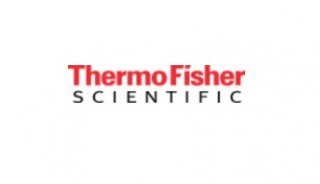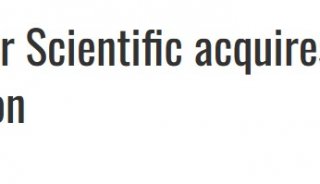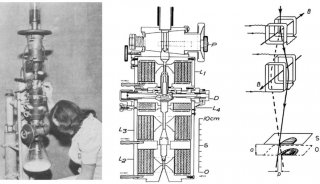ELECTRON MICROSCOPY
E.M. PROCESSING SCHEDULE - EPOXY RESIN
Fix tissue in 2.5% glutaraldehyde in 0.1M sodium cacodylate buffer at 4oC, for a minimum of 4 hours. Tissue should be cut into approx. 1mm cubes for fixing. This may be done in a drop of fix on a sheet of dental wax, using a razor blade. Place in glass processing vials and close with plastic caps. (Tissue may be stored at this stage.)
Wash in 0.1M buffer - 1 hour x 2. (Or overnight at 4oC.)
Post fix in osmium tetroxide in 0.2M buffer - 1 hour. (Mix equal quantities of 2% aqueous OsO4 and 0.4M buffer and use immediately.)
Rinse in 0.2M buffer - 5 mins. x 2.
Dehydrate in 70% ethanol - 20 mins. x 2. (May be stored overnight at this stage if absolutely necessary.)
Dehydrate in 90% ethanol - 10 mins. x 2.
Dehydrate in 100% ethanol - 20 mins. x 2.
Propylene oxide (1.2 epoxy propane) - 10 mins. x 2.
Propylene oxide/epoxy resin mixture (50/50) - 1 hour.
Epoxy resin - overnight - with caps removed from vials. (Allows any remaining propylene oxide to evaporate.)
Embed in labelled capsules with freshly prepared resin.
Polymerise at 60oC - 48 hours.
NOTES
All steps must be performed in a fume cupboard and gloves should be worn throughout.
Osmium tetroxide, propylene oxide and propylene oxide/resin waste should be collected in bottles for safe disposal.
Steps 2 to 11 - processing vials should be on a rotating mixer.
Times at steps 10 and 11 need to be prolonged for tough specimens such as skin, tendon etc.. 2 hours at 10 and several more hours at 11.
For very urgent specimens processing times may be reduced as long as the blocks of tissue are very small. Polymerisation can be achieved in 1 hour at 100oC using gelatine capsules (the polythene ones melt at this temperature). Blocks must be cooled in water and are ready to cut in 15 mins..
E.M. PROCESSING SCHEDULE - ACRYLIC RESIN
Fix tissue in 2.5% glutaraldehyde in 0.1M sodium cacodylate buffer at 4oC, for a minimum of 4 hours. Tissue should be cut into approx. 1mm cubes for fixing. This may be done in a drop of fix on a sheet of dental wax, using a razor blade. Place in glass processing vials and close with plastic caps. (Tissue may be stored at this stage.)
Wash in 0.1M buffer - 1 hour x 2. (Or overnight at 4oC.)
Post fix in osmium tetroxide in 0.2M buffer - 1 hour. (Mix equal quantities of 2% aqueous OsO4 and 0.4M buffer and use immediately.)
Rinse in 0.2M buffer - 5 mins. x 2.
Dehydrate in 70% ethanol - 20 mins. x 2. (May be stored overnight at this stage if absolutely necessary.)
Dehydrate in 90% ethanol - 10 mins. x 2.
Dehydrate in 100% ethanol - 20 mins. x 2.
LR White resin - overnight.
LR White resin - 1 hour.
LR White resin - 1 hour.
Embed in closed, labelled, gelatine capsules with fresh resin.
Polymerise at 60oC - 24 hours. (Polymerise at 50oC for immunocytochemistry.)
NOTES
All steps must be performed in a fume cupboard and gloves should be worn throughout.
Osmium tetroxide/buffer waste should be collected in bottles for safe disposal. Resin waste may be polymerised.
Steps 2 to 10 - processing vials should be on a rotating mixer.
If results are ugently required steps 8-10 may be shortened by performing 4-6 changes of resin at 60oC over 3 hours.
If polymerisation using the accelerator is necessary step 3, osmium tetroxide, must be omitted or artefact will occur due to overheating. Step 3 should also be omitted if immunocytochemistry is to follow. Resin which is nearing its “use by” date should not be used with OsO4 as some polymerisation may occur during step 8.
2.5% glutaraldehyde in 0.1M sodium cacodylate buffer.
Add 1ml of 25% glutaraldehyde stock to 9mls of buffer.
Best prepared and used fresh.
BUFFERS
The pH should be within the range 7.2 - 7.4.(Corrected with 0.1M HCl.)
0.1M sodium cacodylate - 10.7g in 500mls of distilled water.
0.2M sodium cacodylate - 21.4g in 500mls of distilled water.
0.4M sodium cacodylate - 42.8g in 500mls of distilled water.
(Supplier: Agar Scientific, 66A Cambridge Road, Stansted Essex, CM24 8DA, U.K.)
Agar 100 resin - 24g.
DDSA (E.M. grade) - 13g.
MNA (E.M. grade) - 13g.
BDMA - 1ml.
Mix thoroughly in a disposable beaker using a wooden spatula. (May be stored in the freezer compartment of a refrigerator for short periods if tightly sealed.)
(Supplier: London Resin Company, P.O. Box 2139, Reading, Berkshire, RG7 4YG, U.K.)
Use straight from the bottle unless the results are needed urgently in which case the accelerator may be used. The resin will polymerise in approximately 10 minutes using a mixture of 1 drop of accelerator to 10ml of resin. The capsules should be stood on ice, or put in the ice box of a refrigerator, during this time as excessive heat is produced by the reaction.
Osmium tetroxide should not be used in conjunction with the accelerator or if immunocytochemistry is to follow.
STAINS (Impregnation with heavy metals)
Uranyl acetate:
Methanolic - saturated uranyl acetate in 50% methanol.
Aqueous - saturated uranyl acetate in distilled water.
(Keeps for approx. 3 months - store in a brown glass bottle.)
Reynold's lead citrate:
1.33g lead nitrate.
1.76g sodium citrate.
30mls distilled water.
Shake for 1 minute.
Allow to stand for 30 mins. shaking the solution occasionally.
Add 8mls 1M NaOH (Analar) and mix.
Dilute to 50mls with distilled water.
Final pH should be pH12. (Keeps approx. 6 months)
TIMING OF STAINS FOR EPOXY RESIN
Uranyl acetate:
10 mins. for methanolic.
20 mins. for aqueous.
Lead citrate:
5 mins.
TIMING OF STAINS FOR ACRYLIC RESIN
Uranyl acetate:
5 mins. Use aqueous ONLY (alcohol softens the resin).
Lead citrate:
5 mins.
NOTES:
All staining solutions should either be filtered through Millipore filters or centrifuged before use.
Use filtered distilled water to wash between stains and 50% methanol then distilled water to wash if using methanolic uranyl acetate.
Care should be taken not to breathe on the lead citrate whilst staining as a precipitate of lead carbonate may form and contaminate the sections.
AGAR/RESIN EMBEDDING OF CELL SAMPLES
Cell samples suspended in fluid may produce a pellet which is cohesive enough to process after spinning at 5,000 rpm for 5 mins. But if not they should be embedded in high strength agar gel.
Samples are best put straight into fixative upon collection. If they arrive at the laboratory in any other medium spin them in 1.5ml Eppendorf tubes at 5,000 rpm for 5 mins., take off the supernatant, replace it with 2.5% glutaraldehyde in 0.1M sodium cacodylate buffer and leave for a minimum of 4 hours at 4oC.
Decant the fixative and replace with 0.1M sodium cacodylate buffer.
Re-suspend the sample and leave for 2 hours (or overnight) then re-spin.
Prepare a 1% solution of high strength agar in distilled water by bringing to the boil whilst stirring.
Decant the buffer from the sample tubes and take them and the agar solution to the centrifuge.
When the agar solution has cooled to approximately 60oC quickly fill each tube with it, resuspend the samples and spin them at full speed for 30 secs - 1 min. (Maximum of 4 samples at a time or the agar will set before the sample can be spun to the bottom of the tube).
Cool the tubes in a beaker of cold water to set the agar.
Remove the agar plug with a mounted needle and cut off the end containing the sample.
Cut up the sample in agar (1mm cubes) and place in 0.1M sodium cacodylate buffer.
Continue with the E.M. processing schedule from step 3.
RETRIEVAL OF TISSUE FROM HISTOLOGICAL WAX BLOCKS FOR E.M.
In some cases an area of interest, which may not be discovered by simply processing more tissue, can be retrieved from the wax block.
Identify the area of interest on the microscope slide by ringing it with a marker pen.
Match the area marked on the slide against the specimen in the wax block and cut around it with a razor blade.
Cut a few millimetres into the surface of the wax block all around the marked area.
Carefully lever out the piece of tissue.
Cut the piece of tissue into suitable sized blocks making sure that orientation can be recognised later by cutting so that one dimension is greater than the other two.
Place the tissue into a glass processing vial and fill it with a suitable wax solvent (Histo-Clear® or xylene) and leave for 24 hours, (preferably on a rotating mixer).
Place tissue into 100% ethanol for 2 changes of 1 hour each.
Place tissue into 90% ethanol for 2 changes of 30 minutes each.
Place tissue into 70% ethanol for 2 changes of 30 minutes each.
Place tissue into 0.1M sodium cacodylate buffer for 2 changes of 30 minutes each.
Continue with usual processing schedule for E.M. specimens.
The flat (previously cut) surface will be embedded facing the end of the embedding capsule so that the required area is accessible in the finished block.
REMOVAL OF TISSUE SECTION MATERIAL FROM GLASS SLIDES FOR EM
In some cases the area of interest in a histological section is so rare that finding a similar area by removal of tissue from the wax block will not give the required result. In this case it is possible to retrieve the actual tissue from the glass slide for EM.
Ring the area of interest on the top surface of the slide and then mirror that ring on the reverse of the slide with a diamond tipped pen. This will allow the correct positioning of the slide later.
Remove the coverslip by soaking the slide in Histoclear® or xylene until the DPX mountant is loosened.
Soak the slide in Histoclear® or xylene for a further few hours to remove all the mountant.
Place the slide in 100% alcohol for two or three changes of 30-60 minutes each.
Place in a sealed container of LR White® resin for two or three changes of at least 12 hours each.
Either:

Use resin without accelerator. This may be better for any sample that requires immunocytochemistry at a later stage as the use of accelerator generates high temperatures in the resin.
Use a multi-capsule block as single capsules tend to distort during curing and the block gives more support.
Fill 1 capsule completely to the brim with resin so that it is convex at the surface. (See diagram.)
Remove the slide from the coplin jar and drain off as much excess resin as possible.
Place the slide section side down on top of the resin making sure that the marked area of interest is in the centre of the resin.
Polymerise at 50oC for 12-24 hours.
Make up sufficient quantity of LR White® with accelerator to fill one or two EM embedding capsules. 10ml resin : 1 drop accelerator is a convenient quantity.
DO NOT coat the inside of the capsule with extra accelerator.
Fill the EM capsule completely to the brim with resin mixture so that it is convex at the surface. (See diagram.)
Place two empty capsules either side of it on a flat surface for support.
Remove the slide from the coplin jar and drain off as much excess resin as possible.
Place the slide section side down on top of the resin mixture making sure that the marked area of interest is in the centre of the resin.
Allow to polymerise for 15-30 minutes or until hardened.
Or:Spray the reverse of the slide liberally with freezer spray. After a few seconds a crack will often be heard which denotes the partial separation of the resin from the slide.
Snap the capsule from the slide, some force may be necessary. The section of tissue should be embedded in the resin.
Section as soon as possible. The resin has a tendancy to distort gradually after polymerisation which prevents a whole section being taken. Trimming should be kept to an absolute minimum as the tissue is right at the surface of the block and is very thin.
SEMI-THIN SECTIONING
(Allows selection of the appropriate tissue area before proceeding to E.M.)
Several resin sections are cut at approximately 1 micron using glass knives and an ultramicrotome. (The specimen may be advanced by hand using a fine control.)
The sections are dried onto a glass slide on a hotplate at 80oC and then heated over a flame for a few seconds to ensure adhesion.
The sections are then stained with 1% toluidine blue in 1% borax solution for 1 minute at 80oC.
The stain is rinsed off with distilled water and the sections are dried and covered with a glass coverslip using a synthetic mounting medium such as D.P.X.
THIN SECTIONING FOR ELECTRON MICROSCOPY
The sections are cut in the same way as for thick sectioning but using a diamond knife, with the ultramicrotome set to cut at around 100nm using heat advance.
The sections are picked up onto 300 mesh (300 squares), thin-bar, copper grids unless they are for immunocytochemistry, in which case gold or nickel grids are used.
Samples need to be suspended in distilled water or a suitable buffer such as 10mM HEPES (N-2-Hydroxyethylpiperazine-N'-2-ethanesulphonic acid) or 1% ammonium acetate.
Buffers such as P.B.S. may contaminate the grid with salt residues which have to be washed off leaving little contrast.
Fixed or unfixed samples may used. To fix samples spin them down, remove the supernatant and replace it with 2.5% glutaraldehyde in 0.1M sodium cacodylate buffer. Immediately re-suspend the sample in the fix and leave for a minimum of 4hrs at 4oC. (If samples are left in pellet form they will not disperse readily later on). Samples should then be spun, washed and re-suspended in distilled water or one of the above mentioned buffers.
Samples may be taken straight from the culture plate using method C.
Care should be taken with unfixed bacterial or viral samples.











